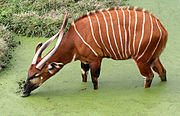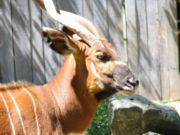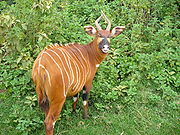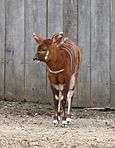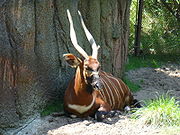
Bongo (antelope)
Background Information
SOS Children, an education charity, organised this selection. See http://www.soschildren.org/sponsor-a-child to find out about child sponsorship.
| Western/Lowland Bongo | |
|---|---|
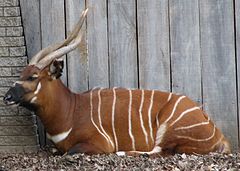 |
|
| Conservation status | |
|
Near Threatened ( IUCN 2.3) |
|
| Scientific classification | |
| Kingdom: | Animalia |
| Phylum: | Chordata |
| Subphylum: | Vertebrata |
| Class: | Mammalia |
| Order: | Artiodactyla |
| Family: | Bovidae |
| Subfamily: | Bovinae |
| Genus: | Tragelaphus |
| Species: | T. e. eurycerus |
| Binomial name | |
| Tragelaphus eurycerus eurycerus Ogilby, 1837 |
|
| Eastern/Mountain Bongo | |
|---|---|
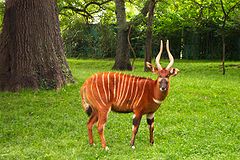 |
|
| Conservation status | |
|
Endangered ( IUCN 2.3) |
|
| Scientific classification | |
| Kingdom: | Animalia |
| Phylum: | Chordata |
| Subphylum: | Vertebrata |
| Class: | Mammalia |
| Order: | Artiodactyla |
| Family: | Bovidae |
| Subfamily: | Bovinae |
| Genus: | Tragelaphus |
| Species: | T. eurycerus isaaci |
| Binomial name | |
| Tragelaphus eurycerus isaaci Ogilby, 1837 |
|
The Western or Lowland Bongo, Tragelaphus eurycerus eurycerus, is a herbivorous, mostly nocturnal forest ungulate and among the largest of the African forest antelope species.
Bongos are characterised by a striking reddish-brown coat, black and white markings, white-yellow stripes and long slightly spiralled horns. Indeed, bongos are the only Tragelaphid in which both sexes have horns. Bongos have a complex social interaction & are found in African dense forest mosaics.
The Lowland Bongo faces an ongoing population decline and the IUCN Antelope Specialist Group considers the western or lowland bongo, T. eurycerus, to be Lower Risk & is classified as near threatened on the conservation status scale.
The Eastern or Mountain Bongo, Tragelaphus eurycerus isaaci, of Kenya has a coat even more vibrant than that of Tragelaphus eurycerus eurycerus. The Mountain Bongo is only found in the wild in one remote region of central Kenya. The Mountain Bongo is classified by the IUCN Antelope Specialist Group as endangered with more specimens in captivity than in the wild.
In 2000, the Association of Zoos and Aquariums (AZA) upgraded the Bongo to a Species Survival Plan (SSP) Participant and in 2006 named the Bongo Restoration to Mount Kenya Project to its list of the Top Ten Wildlife Conservation Success Stories of the year.
Taxonomy
The Bongo belongs to the genus Tragelaphus, which includes the Sitatunga (Tragelaphus spekeii), the Nyala (Tragelaphus angasii), the Bushbuck (Tragelaphus scriptus), the Mountain Nyala (Tragelaphus buxtoni), the Lesser Kudu (Tragelaphus imberbis) and the Greater Kudu (Tragelaphus strepsiceros).
Bongos are further classified into two subspecies: Tragelaphus eurycerus eurycerus, the lowland or "Western Bongo", and the far rarer Tragelaphus eurycerus isaaci, the mountain or "Eastern Bongo" restricted to north-eastern Central Africa. The Eastern Bongo is larger and heavier than the Western Bongo. Two other subspecies are described from West and Central Africa, but taxonomic clarification is required. They have been observed to live up to 19 years.
The scientific name Tragelaphus eurycerus is acquired from Greek words: "Tragelaphus" is derived from the Greek words "Trago" (a he-goat), and "elaphos" (a deer), in combination referring to "an antelope". The word "eurycerus" is originated from the fusion of "eurus" (broad, widespread) and "keras" (an animal's horn). "Bongo" is derived from a West African native name.
Bongos are one of the largest of the forest antelopes. In addition to the deep chestnut colour of their coats, they have bright white stripes on their sides to help camouflage them from their enemies.
Gestation is approximately 285 days (9.5 months) with one young per birth with weaning at 6 months. Sexual maturity is reached at 24-27 months. Adults of both genders are similar in size. Adult height is about 1.1-1.3 meters (3' 8"-4' 3") and length is 1.7-2.5 meters (5' 8"-8' 3"). Females weigh approximately 210-235 kg (460-520 lb), while males weigh approximately 240-405 kg (530 to 895 lb). Both sexes have heavy spiral horns—those of the male are longer and more massive. All bongos in captivity are from the isolated Aberdere Mountain portion of the species’ range in central Kenya.
Distribution and habitat
Bongos are found in dense tropical jungles with dense undergrowth up to an altitude of 4,000 meters (12,800 ft) in Central Africa, with isolated populations in Kenya, and the following west African countries: -
Angola, Benin [regionally extinct?], Burkina Faso, Cameroon, Central African Republic, Congo, The Democratic Republic of Congo, Côte d'Ivoire, Equatorial Guinea, Ethiopia, Gabon, Ghana, Guinea, Guinea-Bissau, Kenya (the only place where the Eastern Bongo are found in the wild), Liberia, Mali, Niger, Sierra Leone, Sudan, Togo [regionally extinct?] and Uganda [regionally extinct] (IUCN, 2002).
Historically, Bongos occurred in three disjunct parts of Africa: East, Central and West. Today all three populations’ ranges have shrunk in size due to habitat loss for agriculture and uncontrolled timber cutting as well as hunting for meat.
Bongos favour disturbed forest mosaics that provide fresh, low-level green vegetation. Such habitats may be promoted by heavy browsing by elephants, fires, flooding, tree-felling (natural or by logging) and fallowing. Mass bamboo die-off provides ideal habitat in East Africa.
Appearance
Coat and body
The bongo sports a bright auburn (colour) or Chestnut (colour) coat, with the neck, chest and legs generally darker than the rest of the body. Coats of male bongos become darker and buffy as they age until they reach a dark mahogany-brown colour. Coats of female bongos are usually more brightly coloured than those of males.
The pigmentation in the coat rubs off quite easily — there are anecdotal reports that rain running off a bongo may be tinted red with pigment.
The smooth coat is marked with 10–15 vertical white-yellow stripes, spread along the back from the base of the neck to the rump. The number of stripes on each side is rarely the same. It also has a short, bristly and vertical brown ridge of hair along the spine from the shoulder to the rump; the white stripes run into this ridge.
A white chevron appears between the eyes and two large white spots grace each cheek. There is another white chevron where the neck meets the chest. The large ears are to sharpen hearing, and the distinctive coloration may help bongos identify one another in their dark forest habitats. Bongos have no special secretion glands and so rely less on scent to find one another than do other similar antelopes. The lips of a bongo are white, topped with a black muzzle.
Horns
Bongos have two heavy and slightly spiralled horns that slope over their back and like in many other antelope species, both the male and female bongos have horns. Bongos are the only Tragelaphid in which both sexes have horns. The horns of bongos are in the form of a lyre and bear a resemblance to those of the related antelope species of nyalas, sitatungas, bushbucks, kudus and elands.
Unlike deer, which have branched antlers that they shed annually, bongos and other antelopes have pointed horns that they keep throughout their lifespan. Males have massive backswept horns while females have smaller, thinner and more parallel horns. The size of the horns range between 75 and 99 centimetres (30–39"). The horns twist once.
Like all other horns of antelopes, the core of a bongo's horn is hollow and the outer layer of the horn is made of keratin, the same material that makes up human fingernails, toenails and hair. The bongo runs gracefully and at full speed through even the thickest tangles of lianas, laying its heavy spiralled horns on its back so that the brush cannot impede its flight. Bongos are hunted for their horns by humans.
Social organization and behaviour
Like other forest ungulates, bongos are seldom seen in large groups. Males, called bulls, tend to be solitary while groups of females with young live in groups of 6 to 8. Bongos have seldom been seen in herds of more than 20. The preferred habitat of this species is so dense and difficult to operate in that few Europeans or Americans observed this species until the 1960s. Current living animals derive solely from Kenyan importations made during the period 1969–1978.
As young males mature and leave their maternal groups they most often remain solitary, although rarely they join-up with an older male. Adult males of similar size/age tend to avoid one another. Occasionally they meet and spar with their horns in a ritualised manner and rarely serious fights will take place. However, such fights are usually discouraged by visual displays, in which the males bulge their necks, roll their eyes and hold their horns in a vertical position while slowly pacing back and forth in front of the other male. They seek out females only at mating time. When they are with a herd of females, males do not coerce them or try to restrict their movements as do some other antelopes.
Although mostly nocturnal, they are occasionally active during the day. However, like deer, it may be that Bongos may exibit crepuscular behaviour.
Bongos are both timid and easily frightened; after a scare a bongo moves away at considerable speed, even through dense undergrowth. They seek cover, where they stand still and alert, facing away from the disturbance and turning their heads from time to time to check on the situation. The bongo's hindquarters are less conspicuous than the forequarters, and from this position the animal can quickly flee.
When in distress the bongo emits a bleat. It uses a limited number of vocalisations, mostly grunts and snorts while females have a weak mooing contact-call for their young. Females prefer to use traditional calving grounds restricted to certain areas, while newborn calves lie in hiding for a week or more, receiving short visits by the mother to suckle.
The calves grow rapidly and can soon accompany their mothers in the nursery herds. Their horns grow rapidly and begin to show in 3.5 months. They are weaned after six months and reach sexual maturity at about 20 months.
Diet
Like many forest ungulates Bongos are herbivorous browsers and feed on tree/bush leaves, bushes, vines, bark and pith of rotting trees, grasses/herbs, roots, cereals, shrubs and fruits.
Bongos require salt in their diet, and are known to regularly visit natural salt licks. Examination of bongo feces revealed that the charcoal from trees burnt by lightning is consumed. They have been known to eat burned wood after lightning storms. This behaviour is believed to be a means of getting salts and minerals into their diet (See Animal Diversity link 2). This behaviour has also been reported in the Okapi. Another similarity to the Okapi, even though the Bongo is unrelated, is that the Bongo has a long prehensile tongue which it uses to grasp grasses & leaves.
Suitable habitats for bongos must have permanent water available. A large animal, the bongo requires an ample amount of food, and is restricted to areas with abundant year-round growth of herbs and low shrubs. Such restrictions have been said to account for the animal's limited distribution.
Population & Conservation
Few estimates of population density are available. Assuming average population densities of 0.25 animals per km² in regions where it is known to be common or abundant, and 0.02 per km² elsewhere, and with a total area of occupancy of 327,000 km², a total population estimate of approximately 28,000 is suggested. Only about 60% are in protected areas, suggesting that actual numbers of the lowland subspecies may only be in the low tens of thousands. In Kenya, their numbers have declined significantly and on Mt. Kenya, they were extirpated within the last decade due to illegal hunting with dogs. Although information on their status in the wild is lacking, Lowland Bongos are not presently considered endangered.
Bongos are susceptible to diseases such as rinderpest, which almost exterminated the species the 1890s. The tragelaphus eurycerus may suffer from goitre. Over the course of the disease, the thyroid glands greatly enlarge (up to 10 x 20 cm) and may become polycystic. Pathogenesis of goiter in the Bongo may reflect a mixture of genetic predisposition coupled with environmental factors, including a period of exposure to a goitrogen.
Leopards, spotted hyenas, lions, and humans prey on them for their pelts, horns and meat; pythons sometimes eat bongo calves. Bongo populations have been greatly reduced by hunting and snares, although some bongo refuges exist.
Although Bongos are quite easy for humans to catch via snares; it is of interest that many people native to the Bongos habitat believed that if they ate or touched Bongo they would have spasms similar to epileptic seizures. Because of this superstition, Bongos were less harmed in their native ranges than expected. However, these taboos are said no longer to exist and that may account for increased hunting by humans in recent times.
Zoo programmes
An international studbook is maintained to help manage animals held in captivity. Because of its bright colour, it is very popular in zoos and private collections. In North America, there are thought to be over 400 individuals, a population that probably exceeds that of the mountain bongo in the wild.
In 2000, the Association of Zoos and Aquariums (AZA) upgraded the Bongo to a Species Survival Plan (SSP) Participant, which works to improve the genetic diversity of managed animal populations. The target population for participating zoos and private collections in North America is 250 animals. Through the efforts of zoos in North America, a reintroduction to the population in Kenya is being developed.
Conservation
In the last few decades there has been a rapid decline in the numbers of wild mountain bongo due to poaching and human pressure on their habitat, with local extinctions reported in Cherangani and Chepalungu hills, Kenya.
The Bongo Surveillance Programme, working alongside the Kenya Wildlife Service, have recorded photos of bongos at remote salt licks in the Aberdare Forests using camera traps, and, by analyzing DNA extracted from dung, have confirmed the presence of bongo in Mount Kenya, Eburru and Mau forests. The programme estimate as few as 140 animals left in the wild - spread across four isolated populations. Whilst captive breeding programmes can be viewed as having been successful in ensuring survival of this species in Europe and North America, the situation in the wild has been less promising. Evidence exists of bongo surviving in Kenya. However, these populations are believed to be small, fragmented & vulnerable to extinction.
Animal populations with impoverished genetic diversity are inherently less able to adapt to changes in their environment (such as climate change, disease outbreaks, habitat change, etc.). The isolation of the four remaining small bongo populations, which themselves would appear to be in decline, means that a substantial amount of genetic material is lost each generation.
Whilst the population remains small, the impact of transfers will be greater, it is for that reason that the establishment of a "metapopulation management plan" occurs concurrently with conservation initiatives to enhance in-situ population growth and why this initiative is both urgent and fundamental to the future survival of Mountain Bongo in the wild.
The western/lowland Bongo faces an ongoing population decline as habitat destruction and meat hunting pressures increase with the relentless expansion of human settlement. Its long-term survival will only be assured in areas which receive active protection and management. At present, such areas comprise about 30,000 km², and several are in countries where political stability is fragile. There is therefore a realistic possibility that its status could decline to Threatened in the near future.
As the largest and most spectacular forest antelope, the western/lowland Bongo is both an important flagship species for protected areas such as national parks, and a major trophy species which has been taken in increasing numbers in Central Africa by sport hunters during the 1990s. Both of these factors are strong incentives to provide effective protection and management of western/lowland bongo populations.
One of the reasons often cited for the popularity of the Bongo as a prized hunting target was a highly-publicized hunting trip taken by Maurice Stans, an official in Richard Nixon's cabinet, to Uganda. During the trip, Stans killed two bongos, and after this, their desirability among wealthy hunters rose substantially.
Trophy hunting has the potential to provide economic justification for the preservation of larger areas of bongo habitat than national parks, especially in remote regions of Central Africa where possibilities for commercially successful tourism are very limited (Wilkie and Carpenter 1999).
The eastern/mountain bongo’s survival in the wild is dependent on more effective protection of the surviving remnant populations in Kenya. If this does not occur, if will eventually become extinct in the wild. The existence of a healthy captive population of this subspecies offers the potential for its reintroduction.
The total number of eastern mountain bongos held in captivity in North America alone may already be similar to or exceed the total number remaining in the wild.
European Zoos Supporting Bongo Conservation in Kenya
In 2004 Woburn Safari Parks' Lindsay Banks & Dr. Jake Veasey (the later is Head of the Department of Animal Management and Conservation at Woburn Safari Park and a member of the European Association of Zoos and Aquariums Population Management Advisory Group), took over responsibility, management & coordination of the European Endangered species Programme (EEP) for the Eastern Bongo. This includes some 250 animals across Europe and the Middle East.
Along with the Rothschild Giraffe the Eastern Bongo is arguably one of the most threatened large mammals in Africa with recent estimates numbering less than 140 animals; below a minimum sustainable viable population. The situation is exacerbated by the fact that these 140 or so animals are spread across four isolated populations. Whilst the Bongo EEP can be viewed as having been successful in ensuring survival of this species in Europe, the EEP has not yet become actively involved in the conservation of this species in the wild in a coordinated fashion. The EEP plan to engage in conservation activities in Kenya to assist in reversing the decline of the Eastern Bongo populations and genetic diversity in Africa, and in particular, applying population management expertise to help ensure the persistence of genetic diversity in the free ranging wild populations.
To illustrate significance of genetic diversity loss; assume the average metapopulation size is 35 animals based on 140 animals spread across four populations (140/4=35). Assuming stable populations, analysis reveals that these populations will haemorrhage 8% of their genetic diversity every decade. By managing all four populations as one - through strategic transfers, gene-loss is reduced from 8% per decade to 2% per decade, without any increase in bongo numbers in Kenya. By managing the European & African populations as one - by strategic exports from Europe combined with in-situ transfers, gene-loss is reduced to 0.72% every 100 years with both populations remaining stable. If populations in Kenya are allowed to grow through the implementation of effective conservation, including strategic transfers, gene-loss can effectively be halted in this species and its future secured in the wild.
The initial aims of the project are: -
1) Through faecal DNA analysis, estimate the genetic diversity of the remaining wild bongo and calculate the relatedness of the isolated wild populations.
2) More accurately estimate the total population of wild bongo through faecal DNA analysis, camera trapping and transect surveying.
3) Through direct sampling, estimate the genetic diversity of the captive bongo population and calculate its relatedness with the remaining isolated wild populations.
4) Collect DNA samples from Western Bongo to calculate the relatedness of the two subspecies.
5) Funding rangers to collect the above data in Kenya, enhance the degree of protection afforded to the Eastern Bongo and level of understanding of its ecological needs.
To realise such a metapopulation management plan, work with local communities is essential to reverse the decline and allow for the implementation of a transfer strategy. It's likely a substantial proportion of wild genetic diversity will have already have been lost.
If effective protection were implemented immediately and bongo populations allowed to expand without transfers, then this would create a bigger population of genetically impoverished bongo. These animals would be less able to adapt to a dynamic environment. Whilst the population remains small, the impact of transfers will be greater. For this reason it's important that the 'metapopulation management plan' occurs concurrently with conservation strategies to enhance in-situ population growth. This is why this initiative is both urgent and fundamental to the future survival of Mountain Bongo in the wild.
Legal status
In 2002 the IUCN, listed the western/lowland species as Near Threatened. This may mean that Bongos may be endangered due to human environmental interaction as well as hunting and illegal actions towards wildlife. CITES lists bongo as an Appendix III species, only regulating their exportation from a single country, Ghana. It is not protected by the U.S. Endangered Species Act and is not listed by USFWS.
The IUCN Antelope Specialist Group considers the western or lowland bongo, T. eurycerus, to be Lower Risk (Near Threatened), and the eastern or mountain bongo, T. e. isaaci, of Kenya to be Endangered. Other subspecific names have been used but their validity has not been tested.
